clutch MAZDA MODEL 5 2006 Owners Manual
[x] Cancel search | Manufacturer: MAZDA, Model Year: 2006, Model line: MODEL 5, Model: MAZDA MODEL 5 2006Pages: 426, PDF Size: 7.18 MB
Page 106 of 426
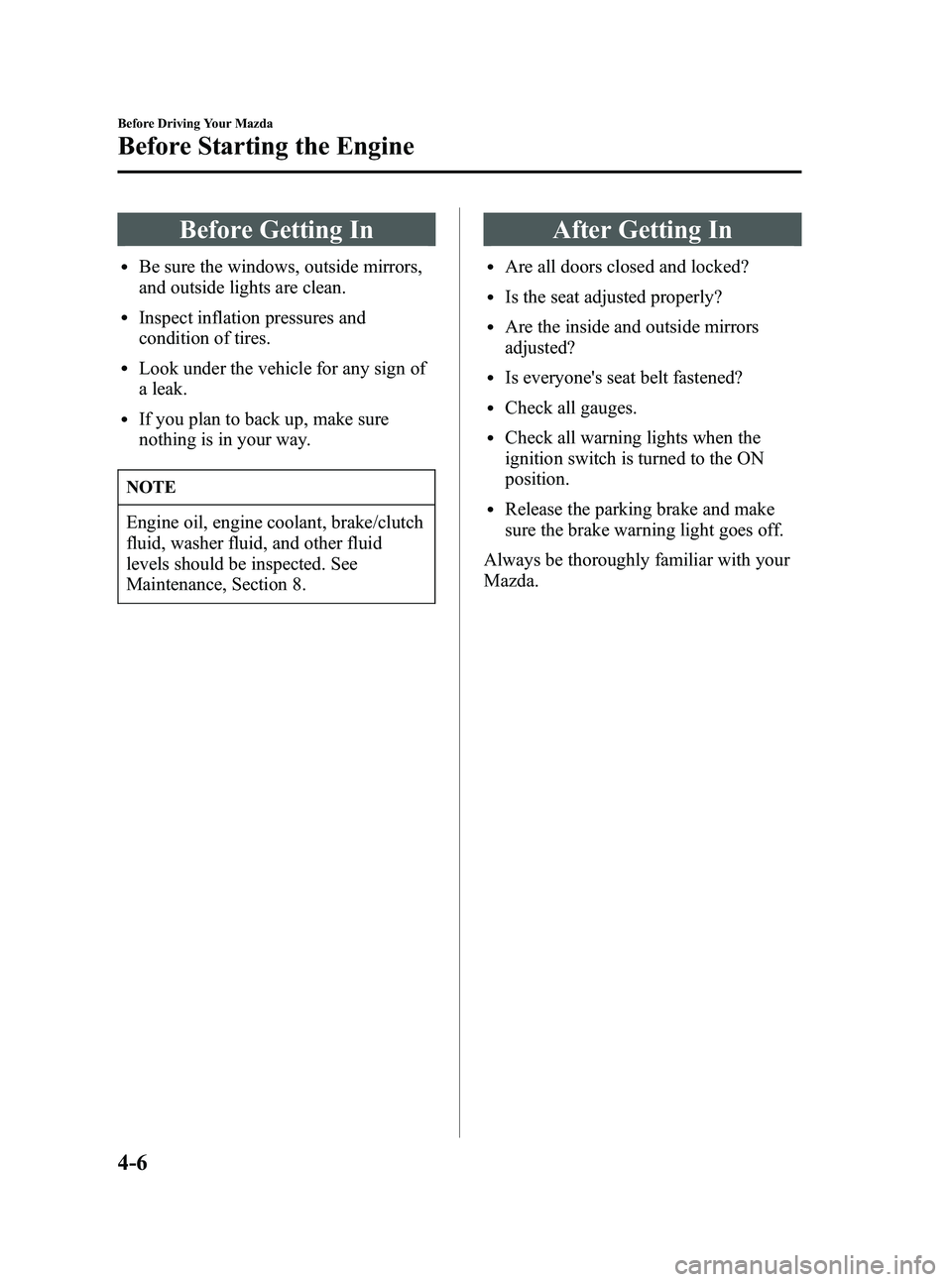
Black plate (106,1)
Before Getting In
lBe sure the windows, outside mirrors,
and outside lights are clean.
lInspect inflation pressures and
condition of tires.
lLook under the vehicle for any sign of
a leak.
lIf you plan to back up, make sure
nothing is in your way.
NOTE
Engine oil, engine coolant, brake/clutch
fluid, washer fluid, and other fluid
levels should be inspected. See
Maintenance, Section 8.
After Getting In
lAre all doors closed and locked?
lIs the seat adjusted properly?
lAre the inside and outside mirrors
adjusted?
lIs everyone's seat belt fastened?
lCheck all gauges.
lCheck all warning lights when the
ignition switch is turned to the ON
position.
lRelease the parking brake and make
sure the brake warning light goes off.
Always be thoroughly familiar with your
Mazda.
4-6
Before Driving Your Mazda
Before Starting the Engine
Mazda3_8U55-EA-05G_Edition3 Page106
Tuesday, September 13 2005 10:41 AM
Form No.8U55-EA-05G
Page 117 of 426
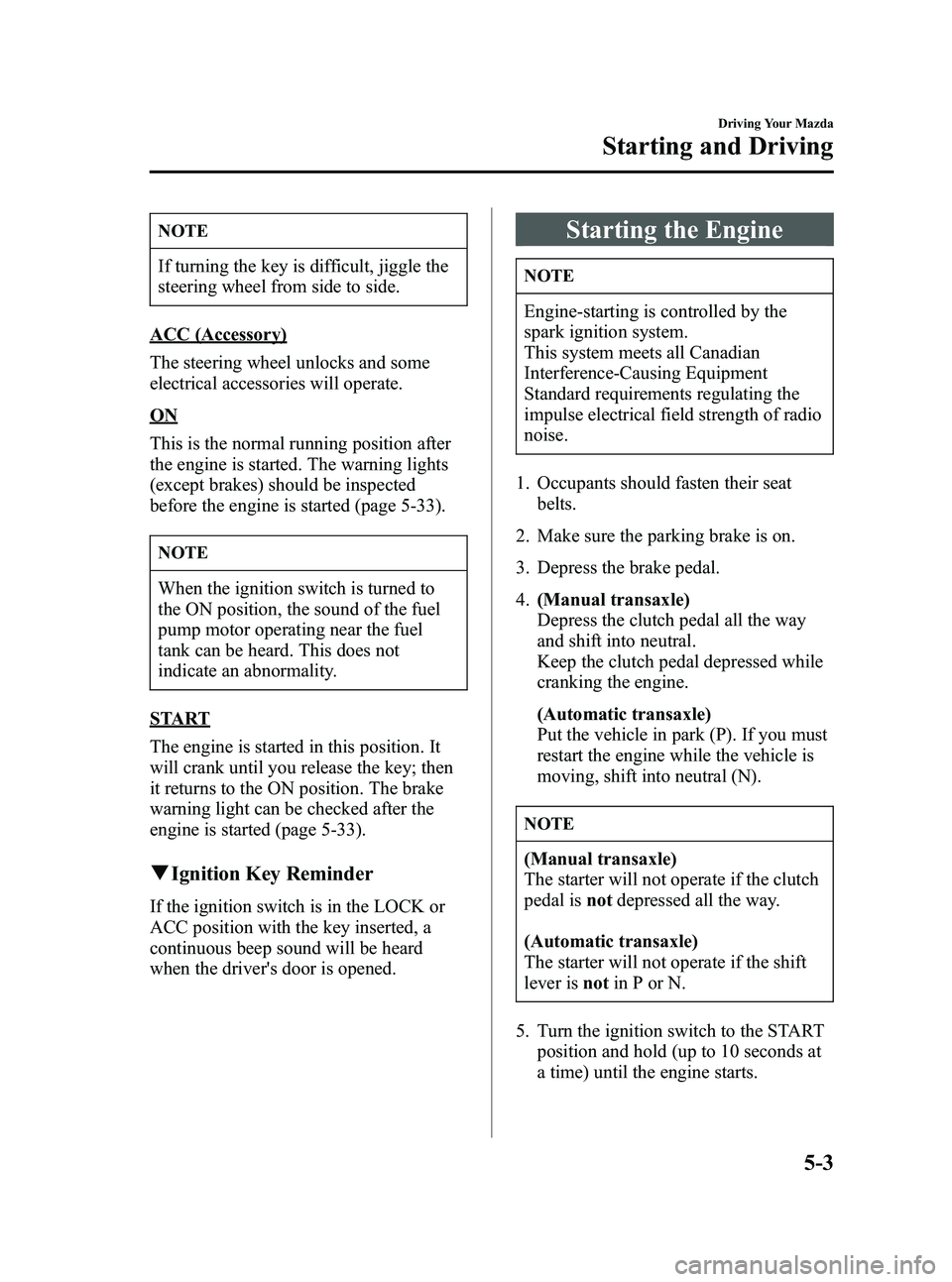
Black plate (117,1)
NOTE
If turning the key is difficult, jiggle the
steering wheel from side to side.
ACC (Accessory)
The steering wheel unlocks and some
electrical accessories will operate.
ON
This is the normal running position after
the engine is started. The warning lights
(except brakes) should be inspected
before the engine is started (page 5-33).
NOTE
When the ignition switch is turned to
the ON position, the sound of the fuel
pump motor operating near the fuel
tank can be heard. This does not
indicate an abnormality.
START
The engine is started in this position. It
will crank until you release the key; then
it returns to the ON position. The brake
warning light can be checked after the
engine is started (page 5-33).
qIgnition Key Reminder
If the ignition switch is in the LOCK or
ACC position with the key inserted, a
continuous beep sound will be heard
when the driver's door is opened.
Starting the Engine
NOTE
Engine-starting is controlled by the
spark ignition system.
This system meets all Canadian
Interference-Causing Equipment
Standard requirements regulating the
impulse electrical field strength of radio
noise.
1. Occupants should fasten their seat belts.
2. Make sure the parking brake is on.
3. Depress the brake pedal.
4. (Manual transaxle)
Depress the clutch pedal all the way
and shift into neutral.
Keep the clutch pedal depressed while
cranking the engine.
(Automatic transaxle)
Put the vehicle in park (P). If you must
restart the engine while the vehicle is
moving, shift into neutral (N).
NOTE
(Manual transaxle)
The starter will not operate if the clutch
pedal is notdepressed all the way.
(Automatic transaxle)
The starter will not operate if the shift
lever is notin P or N.
5. Turn the ignition switch to the START position and hold (up to 10 seconds at
a time) until the engine starts.
Driving Your Mazda
Starting and Driving
5-3
Mazda3_8U55-EA-05G_Edition3 Page117
Tuesday, September 13 2005 10:41 AM
Form No.8U55-EA-05G
Page 123 of 426

Black plate (123,1)
Manual Transaxle Operation
qManual Transaxle Shift Pattern
Neutral position
The shift pattern of the transaxle is
conventional, as shown.
Depress the clutch pedal all the way down
while shifting; then release it slowly.
A safety feature prevents accidental
shifting from 5 to R (reverse). The shift
lever must be put in neutral before being
shifted to R.
WARNING
Sudden Engine-Braking:
Shifting down while driving on wet,
snowy, or frozen roads, or while
driving at high speeds causes sudden
engine braking, which is dangerous.
The sudden change in tire speed could
cause the tires to skid. This could lead
to loss of vehicle control and an
accident. Do not use sudden engine
braking on slippery road surfaces or at
high speeds.
CAUTION
lKeep your foot off the clutch pedal
except when shifting gears. Also,
don't use the clutch to hold the
vehicle on an upgrade. Riding the
clutch will cause needless clutch
wear and damage.
lMake sure the vehicle comes to a
complete stop before shifting to R.
Shifting to R while the vehicle is still
moving may damage the transaxle.
NOTE
If shifting to R is difficult, shift back
into neutral, release the clutch pedal,
and try again.
qRecommendations for Shifting
Upshifting
For normal acceleration, we recommend
these shift points.
Gear Vehicle speed
1 to 2 21 km/h (13 mph)
2 to 3 39 km/h (24 mph)
3 to 4 55 km/h (34 mph)
4 to 5 78 km/h (49 mph)
For cruising
Gear Vehicle speed
1 to 2 18 km/h (11 mph)
2 to 3 29 km/h (18 mph)
3 to 4 47 km/h (29 mph)
4 to 5 68 km/h (42 mph)
Driving Your Mazda
Starting and Driving
5-9
Mazda3_8U55-EA-05G_Edition3 Page123
Tuesday, September 13 2005 10:41 AM
Form No.8U55-EA-05G
Page 135 of 426

Black plate (135,1)
qTo Decrease Cruising Speed
Press the SET/COAST button and hold it.
The vehicle will gradually slow.
Release the button at the speed you want.
Your vehicle has a tap-down feature that
allows you to decrease your current speed
in decrements of 1.6 km/h (1 mph) by a
momentary tap of the SET/COAST
button. Multiple taps will decrease your
vehicle speed 1.6 km/h (1 mph) for each
tap.
qTo Resume Cruising Speed at
More Than 30 km/h (19 mph)
If some other method besides the ON/
OFF switch was used to cancel cruising
speed and the system is still activated, the
most recent set speed will automatically
resume when the RES/ACCEL button is
pressed.
If vehicle speed is below 30 km/h (19
mph), increase the vehicle speed up to 30
km/h (19 mph) and press the RES/
ACCEL button.
qTo Cancel
To turn off the system, use oneof these
methods:
lPress the ON/OFF switch.
lSlightly depress the brake pedal.
lDepress the clutch pedal (Manual
transaxle only).
Driving Your Mazda
Starting and Driving
5-21
Mazda3_8U55-EA-05G_Edition3 Page135
Tuesday, September 13 2005 10:41 AM
Form No.8U55-EA-05G
Page 249 of 426
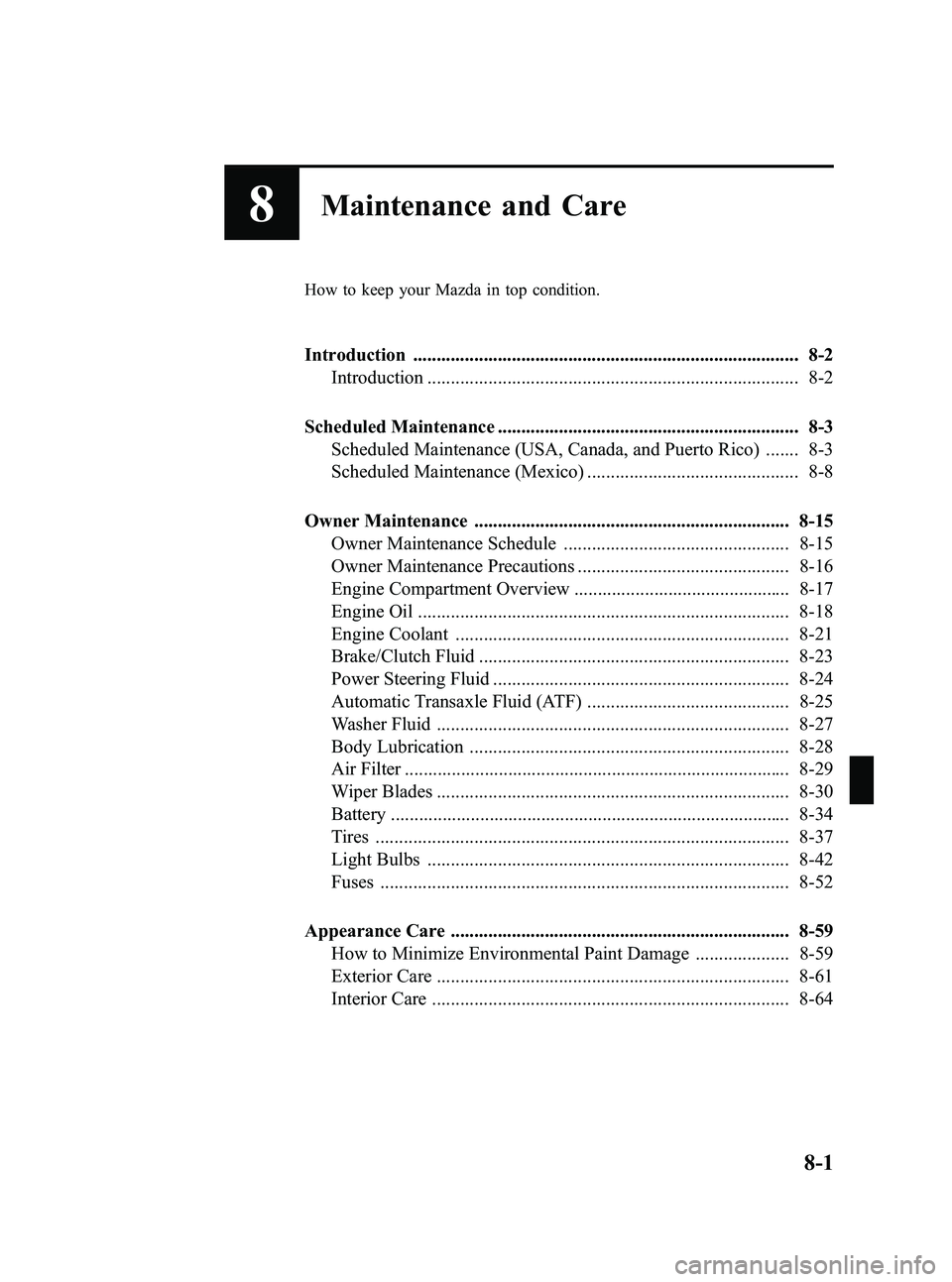
Black plate (249,1)
8Maintenance and Care
How to keep your Mazda in top condition.
Introduction .................................................................................. 8-2Introduction ............................................................................... 8-2
Scheduled Maintenance ................................................................ 8-3 Scheduled Maintenance (USA, Canada, and Puerto Rico) ....... 8-3
Scheduled Maintenance (Mexico) ............................................. 8-8
Owner Maintenance ................................................................... 8-15 Owner Maintenance Schedule ................................................ 8-15
Owner Maintenance Precautions ............................................. 8-16
Engine Compartment Overview .............................................. 8-17
Engine Oil ............................................................................... 8-18
Engine Coolant ....................................................................... 8-21
Brake/Clutch Fluid .................................................................. 8-23
Power Steering Fluid ............................................................... 8-24
Automatic Transaxle Fluid (ATF) ........................................... 8-25
Washer Fluid ........................................................................... 8-27
Body Lubrication .................................................................... 8-28
Air Filter .................................................................................. 8-29
Wiper Blades ........................................................................... 8-30
Battery ..................................................................................... 8-34
Tires ........................................................................................ 8-37
Light Bulbs ............................................................................. 8-42
Fuses ....................................................................................... 8-52
Appearance Care ........................................................................ 8-59 How to Minimize Environmental Paint Damage .................... 8-59
Exterior Care ........................................................................... 8-61
Interior Care ............................................................................ 8-64
8-1
Mazda3_8U55-EA-05G_Edition3 Page249
Tuesday, September 13 2005 10:44 AM
Form No.8U55-EA-05G
Page 254 of 426
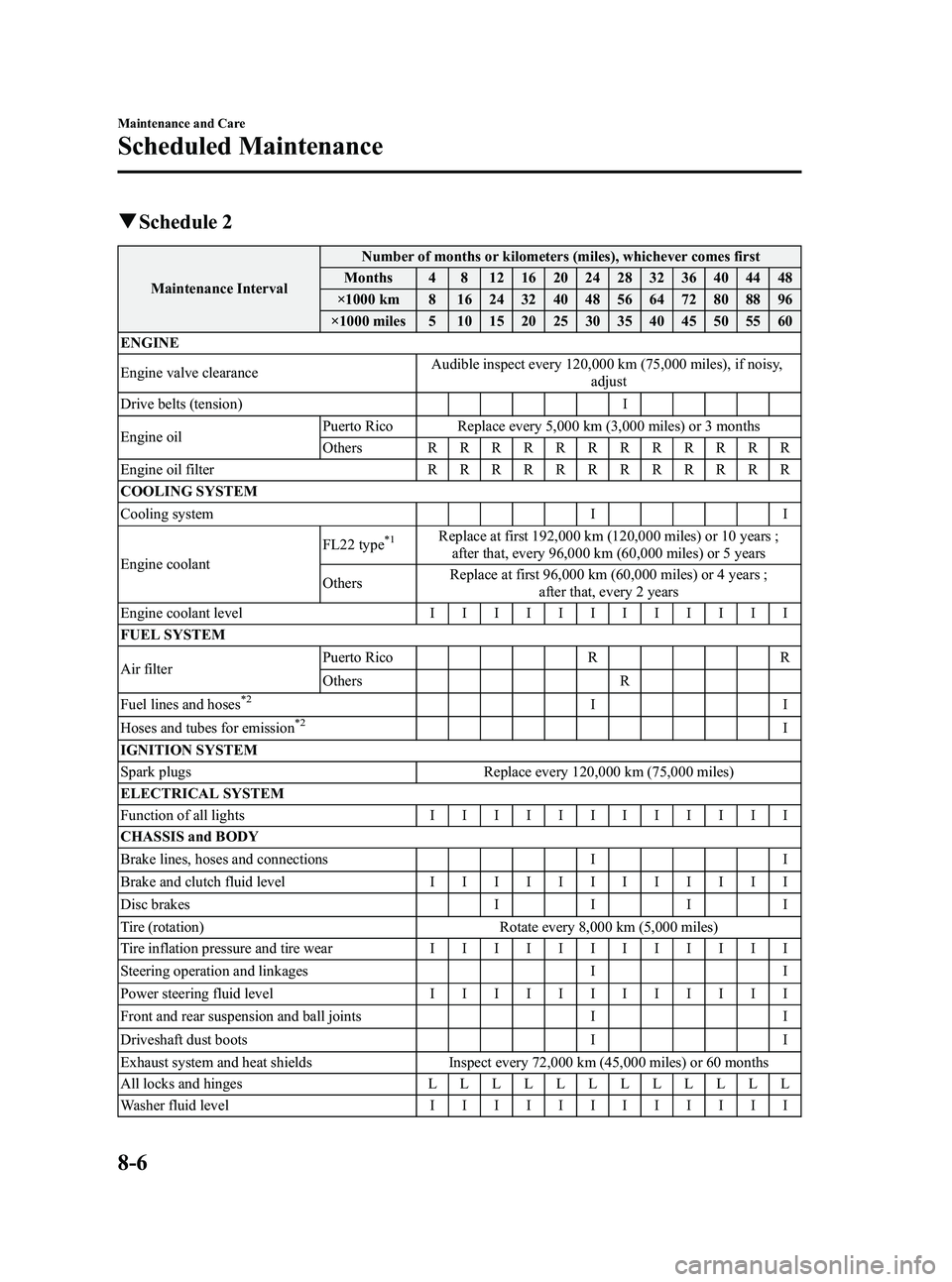
Black plate (254,1)
qSchedule 2
Maintenance Interval Number of months or kilometers (miles), whichever comes first
Months 4 8 12 16 20 24 28 32 36 40 44 48
×1000 km 8 16 24 32 40 48 56 64 72 80 88 96
×1000 miles 5 10 15 20 25 30 35 40 45 50 55 60
ENGINE
Engine valve clearance Audible inspect every 120,000 km (75,000 miles), if noisy,
adjust
Drive belts (tension) I
Engine oil Puerto Rico Replace every 5,000 km (3,000 miles) or 3 months
Others
RRRRRRRRRRRR
Engine oil filter RRRRRRRRRRRR
COOLING SYSTEM
Cooling system II
Engine coolant FL22 type
*1Replace at first 192,000 km (120,000 miles) or 10 years ;
after that, every 96,000 km (60,000 miles) or 5 years
Others Replace at first 96,000 km (60,000 miles) or 4 years ;
after that, every 2 years
Engine coolant level IIIIIIIIIIII
FUEL SYSTEM
Air filter Puerto Rico R R
Others R
Fuel lines and hoses
*2II
Hoses and tubes for emission*2I
IGNITION SYSTEM
Spark plugs Replace every 120,000 km (75,000 miles)
ELECTRICAL SYSTEM
Function of all lights IIIIIIIIIIII
CHASSIS and BODY
Brake lines, hoses and connections I I
Brake and clutch fluid level IIIIIIIIIIII
Disc brakes IIII
Tire (rotation) Rotate every 8,000 km (5,000 miles)
Tire inflation pressure and tire wear IIIIIIIIIIII
Steering operation and linkages I I
Power steering fluid level IIIIIIIIIIII
Front and rear suspension and ball joints I I
Driveshaft dust boots I I
Exhaust system and heat shields Inspect every 72,000 km (45,000 miles) or 60 months
All locks and hinges LLLLLLLLLLLL
Washer fluid level IIIIIIIIIIII
8-6
Maintenance and Care
Scheduled Maintenance
Mazda3_8U55-EA-05G_Edition3 Page254
Tuesday, September 13 2005 10:44 AM
Form No.8U55-EA-05G
Page 263 of 426
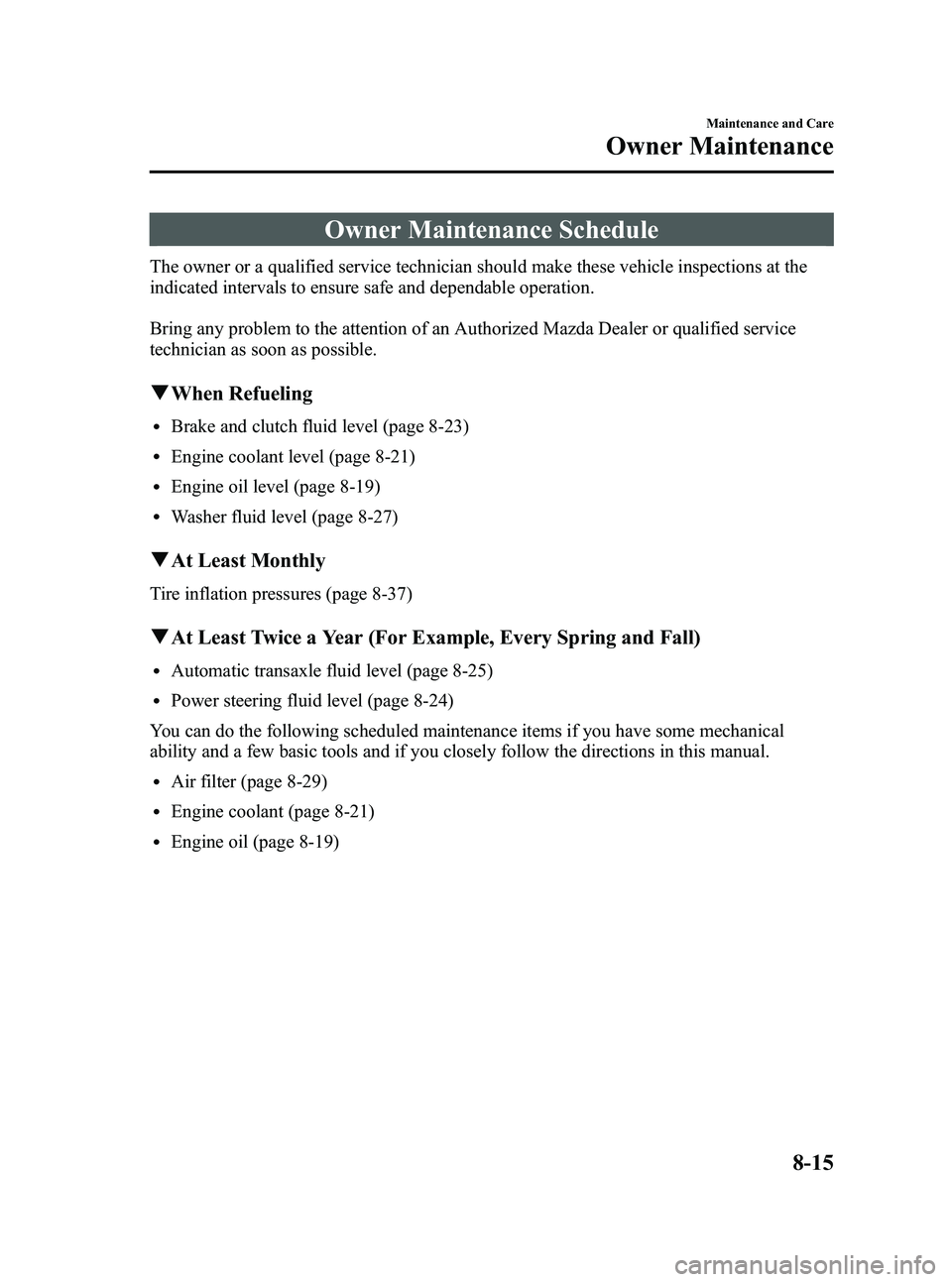
Black plate (263,1)
Owner Maintenance Schedule
The owner or a qualified service technician should make these vehicle inspections at the
indicated intervals to ensure safe and dependable operation.
Bring any problem to the attention of an Authorized Mazda Dealer or qualified service
technician as soon as possible.
qWhen Refueling
lBrake and clutch fluid level (page 8-23)
lEngine coolant level (page 8-21)
lEngine oil level (page 8-19)
lWasher fluid level (page 8-27)
qAt Least Monthly
Tire inflation pressures (page 8-37)
qAt Least Twice a Year (For Example, Every Spring and Fall)
lAutomatic transaxle fluid level (page 8-25)
lPower steering fluid level (page 8-24)
You can do the following scheduled maintenance items if you have some mechanical
ability and a few basic tools and if you closely follow the directions in this manual.
lAir filter (page 8-29)
lEngine coolant (page 8-21)
lEngine oil (page 8-19)
Maintenance and Care
Owner Maintenance
8-15
Mazda3_8U55-EA-05G_Edition3 Page263
Tuesday, September 13 2005 10:44 AM
Form No.8U55-EA-05G
Page 265 of 426

Black plate (265,1)
Engine Compartment Overview
Fuse block
Air filterBattery
Engine oil-filler cap Main fuse
Automatic transaxle fluid-level dipstick
(Only for automatic transaxle) Brake/Clutch fluid
reservoir
Engine coolant
reservoir
Engine oil
dipstick
Power steering
fluid reservoir
Windshield washer
fluid reservoir
Maintenance and Care
Owner Maintenance
8-17
Mazda3_8U55-EA-05G_Edition3 Page265
Tuesday, September 13 2005 10:44 AM
Form No.8U55-EA-05G
Page 271 of 426

Black plate (271,1)
To change coolant
WARNING
Removing the Cooling System Cap:
Removing the cooling system cap
while the engine is running or hot is
dangerous. This might lead to cooling
system and engine damage and could
result in serious injury from escaping
hot coolant or steam. Turn off the
engine and wait until it's cool. Even
then, be very careful when removing
the cap.
Wrap a thick cloth around the cap and
slowly turn it counterclockwise about
two and a half rotations.
Step back while the pressure escapes.
When you're sure all the pressure has
escaped, turn the cap
counterclockwise―still using a cloth
― and remove the cap.
Brake/Clutch Fluid
qInspecting Brake/Clutch Fluid Level
The brakes and clutch draw fluid from the
same reservoir.
Inspect the fluid level in the reservoir
regularly. It should be kept at MAX.
The level normally drops with
accumulated distance, a condition
associated with wear of brake and clutch
linings. If it is excessively low, have the
brake/clutch system inspected by an
Authorized Mazda Dealer.
Maintenance and Care
Owner Maintenance
8-23
Mazda3_8U55-EA-05G_Edition3 Page271
Tuesday, September 13 2005 10:45 AM
Form No.8U55-EA-05G
Page 272 of 426

Black plate (272,1)
qAdding Brake/Clutch Fluid
WARNING
Spilled Brake Fluid:
Spilled brake fluid is dangerous. If it
gets in your eyes, they could be
seriously injured. If this happens,
immediately flush your eyes with water
and get medical attention. Brake fluid
spilled on a hot engine could cause a
fire. Be careful not to spill brake fluid
on yourself or on the engine.
Low Brake/Clutch Fluid Levels:
Low brake/clutch fluid levels are
dangerous. Low levels could signal
brake lining wear or a brake system
leak. Your brakes could fail and cause
an accident. If you find a low fluid
level, have the brakes and clutch
inspected.
If the fluid level is low, add fluid until it
reaches MAX.
Before adding fluid, thoroughly clean the
area around the cap.
CAUTION
lBrake and clutch fluid will damage
painted surfaces. If brake or clutch
fluid does get on a painted surface,
wipe it off immediately.
lUsing nonspecified brake and clutch
fluids (page 10-4) will damage the
systems. Mixing different fluids will
also damage them.
If the brake/clutch system frequently
requires new fluid, consult an
Authorized Mazda Dealer.
Power Steering Fluid
q Inspecting Power Steering Fluid
Level
CAUTION
To avoid damage to the power steering
pump, don't operate the vehicle for long
periods when the power steering fluid
level is low.
NOTE
Use specified power steering fluid
(page 10-4).
Inspect the fluid level in the reservoir at
each engine oil change with the engine off
and cold. Add fluid if necessary; it does
not require periodic changing.
The level must be kept between MIN and
MAX.
Visually examine the lines and hoses for
leaks and damage.
If new fluid is required frequently, consult
an Authorized Mazda Dealer.
8-24
Maintenance and Care
Owner Maintenance
Mazda3_8U55-EA-05G_Edition3 Page272
Tuesday, September 13 2005 10:45 AM
Form No.8U55-EA-05G